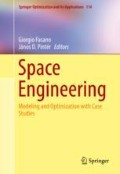Abstract
In this chapter, a method to assess the occurrence of impacts between objects (either spacecraft or space debris) orbiting around the Earth is presented. The method is based on the computation of the minimum distance between two evolving orbits by means of a rigorous global optimizer. Analytical solutions of artificial satellite motion are utilized to account for perturbative effects of Earth’s zonal harmonics, atmospheric drag, and third body. It is shown that the method can effectively compute the intersection between perturbed orbits and hence identify pairs of space objects on potentially colliding orbits. Test cases considering sun-synchronous, low perigee and earth-synchronous orbits are presented to assess the performances of the method.
Notes
- 1.
http://www.space-track.org.
- 2.
http://www.celestrack.org.
- 3.
The computational time can indeed be reduced almost linearly performing parallel computation on many processors as COSY-GO has a fully parallel implementation.
References
Aksnes, K.: On the use of Hill variables in artificial satellite theory: Brouwer’s theory. Astron. Astrophys. 17, 70–75 (1972)
Armellin, R., Di Lizia, P., Berz, M., Makino, K.: Computing the critical points of the distance function between two Keplerian orbits via rigorous global optimization. Celestial Mech. Dyn. Astron. 107, 377–395 (2010)
Astronomical Almanac for the Year 2007, United States Government Printing Office (2006)
Baluyev, R.V., Kholshevnikov, K.V.: Distance between two arbitrary unperturbed orbits. Celestial Mech. Dyn. Astron. 91, 287–300 (2005)
Berz, M.: Modern Map Methods in Particle Beam Physics. Academic Press, San Diego (1999)
Berz, M., Makino, K.: COSY INFINITY Version 9 reference manual. MSU Report MSUHEP-060803, Michigan State University, East Lansing, MI 48824, pp. 1–84 (2006)
Berz, M., Bischof, C., Corliss, G., Griewank, A.: Computational Differentiation: Techniques, Applications, and Tools, pp. 1–419. SIAM, Philadelphia (1996)
Berz, M., Makino, K., Kim, Y.: Long-term stability of the tevatron by verified global optimisation. Nucl. Instrum. Methods A558, 1–10 (2005)
Dybczynski, P.A., Jopek, T.J., Serafin, R.A.: On the minimum distance between two Keplerian orbits with a common focus. Celestial Mech. Dyn. Astron. 38, 345–356 (1986)
Explanatory Supplement to the Astronomical Ephemeris and the American Ephemeris and Nautical Almanac (1961)
Fornberg, B.: Generation of finite difference formulas on arbitrarily spaced grids. Math. Comput. 51, 699–706 (1988)
Griewank, A., Corliss, G.F.: Automatic Differentiation of Algorithms, pp. 25–31. SIAM, Philadelphia (1991)
Gronchi, G.F.: On the stationary points of the squared distance between two ellipses with a common focus. SIAM J. Sci. Comput. 24, 61–80 (2002)
Gronchi, G.F.: An algebraic method to compute the critical points of the distance function between two Keplerian orbits. Celestial Mech. Dyn. Astron. 93, 295–329 (2005)
Hoot, F.R.: Reformulation of the Brower geopotential theory for improved computational efficiency. Celestial Mech. 24, 367–375 (1981)
Hoots, F.R.: An analytical satellite theory using gravity and a dynamic atmosphere. In: AIAA/AAS Astrodynamics Conference (1982)
Hoots, F.R., Roehrich, R.L.: Models for Propagation of the NORAD Elements Sets, Project SPACETRACK, Rept. 3 (1980)
Hoots, F.R., France, R.G.: An analytical satellite theory using gravity and a dynamic atmosphere. Celestial Mech. 40, 1–18 (1987)
Hoots F.R., Schumacher, P.W., Glover, R.A.: History of analytical orbit modeling in the U.S. space surveillance system. J. Guid. Control Dyn. 27, 174–185 (2004)
Hujsak, R.S.: A restricted four body solution for resonating satellites with an oblate earth. In: American Institute of Aeronautics and Astronautics Conference (1979)
Kearfott, R.B.: Rigorous Global Search: Continuous Problems, pp. 169–199. Kluwer Academic Publishers, Dordrecht (1996)
Kholshevnikov, K.V., Vassiliev, N.N.: On the distance function between two Keplerian elliptic orbits. Celestial Mech. Dyn. Astron. 75, 75–83 (1999)
Lowan, A.N., Davis, N., Levenson, A.: Table of the zeros of the Legendre Polynomials of order 1–16 and the weight coefficients for Gauss’ mechanical quadrature formula. Bull. Am. Math. Soc. 48, 739–743 (1942)
Lyddane, R.H.: Small eccentricities or inclinations in the Brower theory of the artificial satellite. Astron. J. 68, 555–558 (1963)
Makino, K.: Rigorous Analysis of Nonlinear Motion in Particle Accelerators. Ph.D. Thesis, Michigan State University, East Lansing, MI, pp. 76–136 (1998)
Makino, K., Berz, M.: Efficient control of the dependency problem based on Taylor model methods. Reliab. Comput. 5, 3–12 (1999)
Makino, K., Berz, M.: Taylor models and other validated functional inclusion methods. Int. J. Pure Appl. Math. 6, 239–316 (2003)
Makino, K., Berz, M.: Verified global optimization with Taylor model-based range bounders. Trans. Comput. 11, 1611–1618 (2005)
Morselli A.: The space debris problem: collision risk assessment for perturbed orbits via rigorous global optimization, M.Sc. Thesis, Politecnico di Milano, Milan (2011)
Sitarski, G.: Approaches of the parabolic comets to the outer planets. Acta Astronaut. 18, 171–19 (1968)
Vallado, D.A., Crawford, P., Hujsak, R., Kelso, T.S.: Revisiting SPACETRACK Report # 3: Rev. 1, AIAA/AAS Astrodynamics Specialist Conference and Exhibit (2006)
Author information
Authors and Affiliations
Corresponding author
Editor information
Editors and Affiliations
Rights and permissions
Copyright information
© 2016 Springer International Publishing Switzerland
About this chapter
Cite this chapter
Morselli, A., Armellin, R., Di Lizia, P., Bernelli-Zazzera, F. (2016). Rigorous Global Optimization for Collision Risk Assessment on Perturbed Orbits. In: Fasano, G., Pintér, J.D. (eds) Space Engineering. Springer Optimization and Its Applications, vol 114. Springer, Cham. https://doi.org/10.1007/978-3-319-41508-6_9
Download citation
DOI: https://doi.org/10.1007/978-3-319-41508-6_9
Published:
Publisher Name: Springer, Cham
Print ISBN: 978-3-319-41506-2
Online ISBN: 978-3-319-41508-6
eBook Packages: Mathematics and StatisticsMathematics and Statistics (R0)

